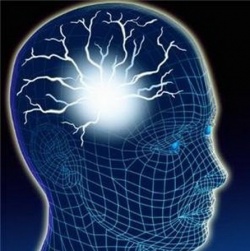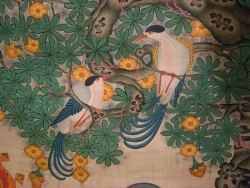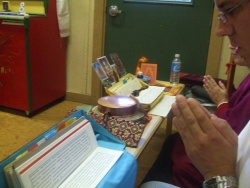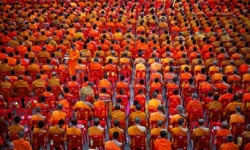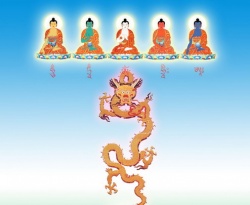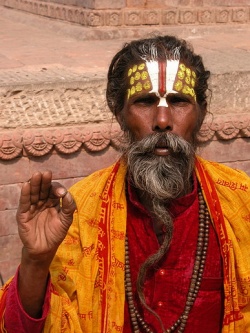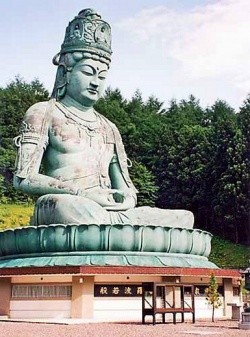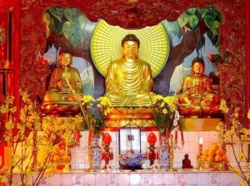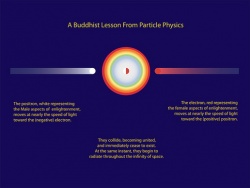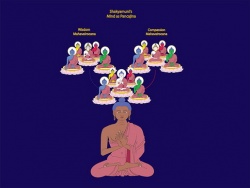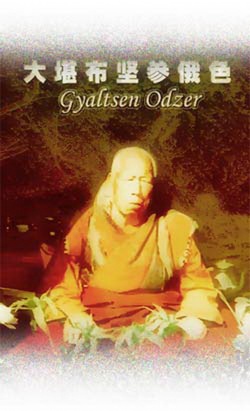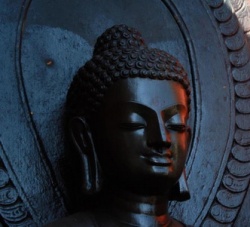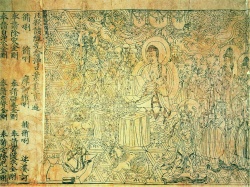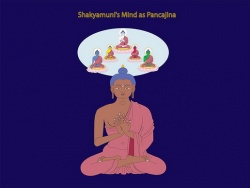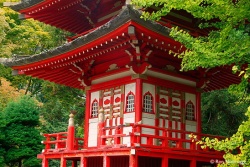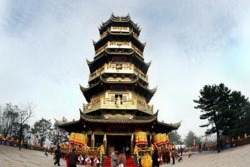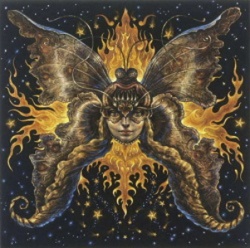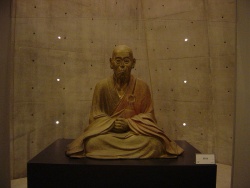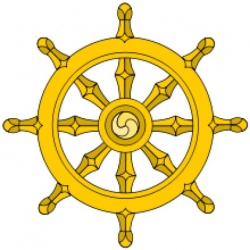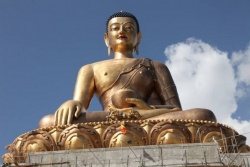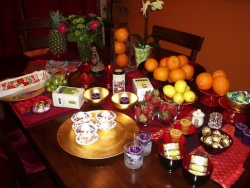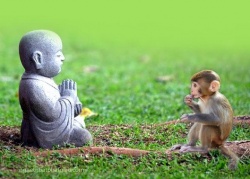Hs''uan-tsang's Translations and Works
A survey of Hs"uan-tsang's prolific translations demonstrates that he was anything but a narrow sectarian. His translations cover the gamut of Buddhist literature including: suutras and `saastras of interest to Yogaacaara; Madhyamaka texts; Pure Land texts; Sarvaastivaadin Abhidharma works; Tantric texts; a Hindu Vai`se.sika text; works on logic and epistemology; Abhidharma texts; Dhaaranii texts; Avadaana texts; Mahaayaana suutras; Vaipulya suutras; Suutras concerned with pratiitya-samutpaada, Buddha's teachings just before his parinirvaa.na, instructions to rulers; Pratimok.sa texts; Praj~naapaaramitaa texts; his travelogue; texts devoted to Avalokite`svara, Maitreya, Bhai.sajya-guru (the Medicine Buddha), K.sitigarbha, Amitaabha; etc. His works are spread throughout the Taishou edition of the Chinese Buddhist canon, which is organized according to literary or sectarian type, demonstrating that he contributed to every genre. Some of his translations, such as the Heart Sutra and Diamond Sutra, have remained at the center of East Asian Buddhist study and devotion. Others, such as his translation of the Vimalakiirti-nirde`sa suutra, were overshadowed by translations done by others. Some are very short works, others are of unparalleled length (his translation of the Mahaapraj~naapaaramitaa suutras fills three Taishou volumes! No other Chinese Buddhist text comes close).
The list is chronological. For some texts we have very precise dates, but for others there is little or no information. There are some controversies concerning the place or date of certain texts; some of these I have noted, others I have ignored.
For each work I have provided the Chinese title; the number of fascicles; the Sanskrit title when it is known (reconstructed Sanskrit titles are preceded by an asterisk); in most cases an English translation of the title (if the meaning of the Chinese title differs from the known Sanskrit title, or represents only one possible interpretation of the Sanskrit, I have translated the Chinese); the Taishou number (volume, followed by text number); the date and place of translation (or where the text was completed); the original author; and annotations placing the text in context. (Again, for fuller discussion, cf. Buddhist Phenomenology).
The short Notes appended to many of the items in this list are intended not just to provide information, but to stimulate further interest in Xuanzang's corpus. Anyone who has a translation or summary or discussion (published or unpublished) of any of these texts who would like to share it with others through this site is encouraged to contact the webmasters, Dan Lusthaus or Charles Muller. In the near future, on-line versions of these texts will be available through hyperlink.
Year 645
1. Ta p'u-sa tsang ching 大菩薩藏經 (20 fasc)
Bodhisattva pi.taka-suutra.
(Sutra of the Scriptural-Basket of the Great Bodhisattva)
(included in T.11.310 (suutra 12] secs. 35-54)
Hung-fu (Vast Prosperity Monastery 弘褔寺
NOTE: Part of the Ratnakuuta suutra. The brunt of the Ratnakuuta was translated by Bodhiruci (706) and Dharmarak.sa (313), though many other translators contributed selections. According to Hs"uan-tsang's biography, the last text he was asked to translate was the complete Ratnakuuta. He began, but sickness and old age prevented him from getting very far. Since tsang ching was the first text he translated upon returning to China, that brought his work full circle.
2. Hsien-yang sheng-chiao lun sung 顯揚聖教論頌 (1 fasc)
(Exposition of the aarya Teachings, Verse Treatise)
T.31.1603 (cf. 5 below) July 8, Hung-fu Monastery
Author: Asa`nga 無著
NOTE: Asa`nga text based on the Yogaacaabhuumi (see 10, below). Dignaaga is said to have written a commentary, titled Yogaavataara, not extant, on its ninth chapter.
3. Fo ti ching 佛地經 (1 fasc)
Buddha-bhuumi suutra
(Buddha-Stage Sutra)
T.16.680 (cf. 30 below) August 12, Hung-fu Monastery
4. Liu-men t'o-lo-ni ching 六門陀羅可i經 (1 fasc)
Sa.nmukhi-dhaaranii
(Six Gates Dhaaranii Sutra)
T.21.1360 October 11, Hung-fu Monastery
NOTE: The Six Gates are the senses; Dhaaranii, like mantra, is an enabling chant or invocation.
5. Hsien-yang sheng-chiao lun 顯揚聖教論 (20 fasc)
(Exposition of the Aarya Teachings)
T.31.1602 (cf. 2 above) Oct 645-Feb. 646, Hung-fu Monastery
Author: Asa`nga 無著
NOTE: Asa`nga's exposition on the verses of *Prakara.naaryavaakaa (2 above).
Year 646
6. Ta-sheng a-p'i-t'a-mo tsa-chi lun 大乘阿毗達摩雜集論 (16 fasc)
Abhidharmasamuccaya-vyaakhyaa
(Mahaayaana Abhidharma Mixed-Collection Treatise)
(T.31.1606) (cf. 47 below) Feb. 7-April 19, Hung-fu Monastery
Author: Sthiramati 安慧
NOTE: Sthiramati's commentary (called Tsa-chi lun 雜集論 for short) to Asa`nga's Abhidharmasamuccaya (called Chi lun 集論 for short). This is the only text by Sthiramati translated by Hs"uan-tsang. K'uei-chi wrote a commentary on it. The Tibetan tradition attributes the Tsa-chi lun to Jinaputra.
7. (Ta-T'ang) Hsi-y"u chi (大唐)西域記 (12 fasc)
(Great T'ang) Record of Western Regions
T.51.2087 Hung-fu Monastery
Author: Hs"uan-tsang 玄奘
NOTE: Written at the behest of the Emperor, this is Hs"uan-tsang's travelog of his journey through Central Asia and India, and remains one of our most valuable records of those regions in the seventh century. Includes abundant material on customs, Buddhist legends, population, etc. "Great T'ang" signifies the T'ang Dynasty, and in a broader sense China.
Year 647
8. Ta-sheng wu-yun lun 大乘五蘊論 (1 fasc) Pa~ncaskandhaka-prakara.na
(Mahaayaana Treatise on the Five Skandhas)
T.31.1612 April 4, Hung-fu Monastery
Author: Vasubandhu 世親
NOTE: A proto-Yogaacaara work by Vasubandhu.
9. She ta-sheng lun wu-hsing shih 攝大乘論無性釋 (10 fasc)
(*Asvabhaava's commentary on the Mahaayaanasa`ngraha)
T.31.1598 (cf. 18, 19)
April 10, 647-July 31, 649, Ta-tz'u-en (Great Compassion) Monastery 大慈恩寺
Author: *Asvabhaava 無性
NOTE: *Asvabhaava's commentary on Asa`nga's Mahaayaanasa`ngraha, one of several versions of the Mahaayaanasa`ngraha translated by Hs"uan-tsang as part of his effort to correct the misunderstandings among Chinese Buddhists derived from Paramaartha's translations. The Mahaayaanasa`ngraha, or She-lun 攝論 for short, was a key text for Paramaartha's followers.
10. Y"u-ch'ieh shih-ti lun 瑜伽師地論 (100 fasc)
Yogaacaarabhuumi saastra
(Stages of Yoga Practice Treatise)
T.30.1579 July 3, 646-June 11 648, Hung-fu & Ta-tz'u-en Monasteries
Author: Maitreya 彌勒
NOTE: This massive work, attributed in the Chinese tradition to Maitreya and in the Tibetan tradition to Asa`nga, served as the grand Yogaacaara encyclopedia for Hs"uan-tsang, who originally went to India to procure a complete copy of this text. Paramaartha had done a partial translation (T.30.1584). A detailed outline of this text can be found elsewhere on this site. Go there now
11. Chieh shen mi ching 解深密經 (5 fasc)
Sa`ndhinirmocana suutra
(Sutra Explaining the Deep Secret)
T.16.676 August 8, Hung-fu Monastery
NOTE: The Sa`ndhinirmocana is generally considered the first suutra to present many of the distinctively Yogacaric doctrines, such as vij~napti-maatra, tri-svabhaava, etc. It was translated into Chinese many times, including by Bodhiruci (in 514, T.16.675), Paramaartha (in 557, T.16.677), and Gu.nabhadra (in 435-43, T.16.678 and 679).
12. Yin ming ju cheng-li lun 因明入正理論 (1 fasc)
Nyaayaprave`sa
(Introduction to Logic)
T.31.1630 Sept. 10, Hung-fu Monastery
Author: `Sa`nkarasvaamin 商羯羅主
NOTE: The first Indian Logic text ever translated into Chinese. It offers an overview of Dignaaga's logic. Ten monks wrote commentaries on this text which were incommensurate. A Court Taoist, L"u Tsai, wrote his own applying yin-yang and Chinese cosmological principles, which outraged the Buddhists, leading to a crisis in the capital that only dissipated once Hs"uan-tsang, questioned by the Emperor, confirmed that L"u's commentary was erroneous.
Year 648
13. T'ien ch'ing-wen ching 天請問經 (1 fasc)
Devataa suutra
(Questioning Devas Sutra)
T.15.593 April 17, Hung-fu Monastery
14. Shih-ch"u yi lun 十句義論 (1 fasc)
Vai`se.sika-da`sapadaartha `saastra
(Treatise on the Ten Padaarthas)
T.54.2138 June 11, Hung-fu Monastery
Author: Maticandra 慧月
NOTE: A Hindu Vai`se.sika text. Padaarthas are the basic components of reality. Vai`se.sikas more commonly list nine, rather than ten, padaarthas.
15. Wei-shih san-shih lun 唯識三十論 (1 fasc)
Tri.m`sikaa
(Thirty Verses on Vij~napti-maatra Treatise)
T.31.1586 June 25, Hung-fu Monastery
Author: Vasubandhu 世親
NOTE: The root text on which the Ch'eng wei-shih lun expounds. The Chinese title would literally translate into Sanskrit as Tri.m`sikaa-vij~napti-maatra `saastra.
16. Chih-kang po-lo ching 金剛般若經 (1 fasc)
Vajracchedikaa suutra
(Diamond Sutra)
T.7.220 Ta-tz'u-en Monastery
NOTE: There are several Chinese translations of the Diamond Sutra, including by Kumaarajiiva (401), Bodhiruci (509), Paramaartha (558), and I-ching (703), but Hs"uan-tsang's rendition became the standard in East Asia.
17. Pai -fa ming-men lun 百法明門論 (1 fasc)
Mahaayaana `satadharmaa-prakaa`samukha `saastra
(Lucid Introduction to the One Hundred Dharmas)
T.31.1614 December 7, Hung Fa Hall 弘法院
Author: Vasubandhu 世親
NOTE: Vasubandhu's enumeration of the Yogaacaara One Hundred Dharma list, divided up by categories.
An outline of this text is available on this site. Go there now
18. She ta-sheng lun shih-ch'in shih 攝大乘論世親釋 (10 fasc)
Mahaayaanasa`ngraha-bhaa.sya
(Vasubandhu's commentary on the Mahaayaanasa`ngraha)
T.31.1597 (cf. 9 and 19) [[Northern Palace 北闕 and Ta-tz'u-en Monastery
Author: Vasubandhu 世親
Year 649
19. She ta-sheng lun pen 攝大乘論本 (3 fasc)
Mahaayaanasa`ngraha
(Encyclopedia of Mahaayaana)
T.31.1594 (cf. 9 and 18) Jan. 14-July 31, Ta-tz'u-en Monastery
Author: Asa`nga 無著
NOTE: Paramaartha's version of this text by Asa`nga had become very popular in sixth century China and its influence was still pervasive in Hs"uan-tsang's day. That Hs"uan-tsang chose to translate complete commentaries on the She lun 攝論 (9 and 18 above), including one by Vasubandhu, before translating the root text indicates his purpose was to replace misconceptions engendered by erroneous ideas introduced to China by Paramaartha's translation. Before offering a different version of the text, Hs"uan-tsang provided authoritative commentaries undermining Paramaartha's emendations.
20. Y"uan-ch'i sheng-tao ching 緣起聖道經 (1 fasc)
Nidaana suutra
(Sutra of Aarya Teachings on Conditioned Arising)
T.16.714 (cf. 34, 71) Feb. 17, Hung Fa Hall
NOTE: A sutra on pratiitya-samutpaada.
21. Shih-shen tsu lun 識身足論 (16 fasc)
Abhidharma Vij~naana-kaaya paada `saastra
(Discourse on Consciousness Body)
T.26.1539 March 3-Sept. 19, Hung Fa Hall and Ta-tz'u-en Monastery
Author: Devak.sema 提婆設摩
NOTE: The third text of the Sarvaastivaada Abhidharma canon.
22. Ju-lai shih-chiao sheng ch"un wang ching 如來示教勝軍王經 (1 fasc)
Raajavavaadaka suutra
(Sutra where Tathaagata Reveals Teachings to King Prasenajit)
T.14.515 (cf. 26) March 24, Ta-tz'u-en Monastery
NOTE: Buddha teaches King Prasenajit how to be a good king. For Hs"uan-tsang this sutra probably had at least two implications. First, his Indian friend and pivotal teacher was also named Prasenajit 勝軍 (see Chapter Fifteen of Buddhist Phenomenology). King Prasenajit was Buddha's contemporary and alter-ego: born the same day as Buddha, he inherited his own father's throne, unlike Buddha who rejected his to become a mendicant; King Prasenajit eventually becomes Buddha's disciple. Second, it provided a response to the Chinese emperor who, due to military ambitions, had been pressuring Hs"uan-tsang for information about the territoritories to the West of China. The Hsi-y"u chi (see 7, above) was one response, providing detailed information on monasteries, geography, and customs, but little that would be of military use.
23. Shen hsi yu ching 甚希有經 (1 fasc)
(Sutra on Most Rarified Existence)
T.16.689 July 2, Ts'ui-wei Palace 翠微宮, Chung Nan Mt. 終南山
24. Po-lo hsin ching 般若心經 (1 fasc)
Praj~naa-paaramitaa h.rdaya suutra
(Heart Sutra)
T.8.251 July 8, Ts'ui-wei Palace
NOTE: Full title: Po-lo po-lo-mi-to hsin ching 般若波羅密多心經. Translated many times into Chinese, Hs"uan-tsang's version has become the standard version. Very popular in China, Korea and Japan, this version has been chanted daily throughout East Asia by clerics and laypeople for over a thousand years. There are many English translations.
25. P'u-sa chieh chieh mo 菩薩ii棌~磨 (1 fasc)
(Elaboration of On Conferring Bodhisattva Vinaya)
T.24.1499 (cf. 28) August 28, Ta-tz'u-en Monastery
Author: Maitreya 彌勒
NOTE: This text is drawn from the Yogaacaarabhuumi (see 10, above).
26. Wang fa cheng-li ching 王法正理經 (1 fasc)
([[Sutra of Maitreya's Correct {Principles of Royal Rule]])
T.31.1615 (cf. 22) August 31, Ta-tz'u-en Monastery
Author: Maitreya 彌勒
27. Tsui wu-pi ching 最無比經 (1 fasc)
(Supreme Incomparable Sutra)
T.16.691 Sept. 1, Ta-tz'u-en Monastery
28. P'u-sa chieh pen 菩薩戒本(1 fasc)
(On Conferring Bodhisattva Vinaya)
T.24.1501 (cf. 25) Sept. 3, Ta-tz'u-en Monastery (or Ts'ui-wei Palace in 647)
Author: Maitreya 彌勒
NOTE: Bodhisattva Pratimok.sa attributed in China to Maitreya, and in Tibet to Asa`nga. This served as the Yogaacaara pratimok.sa, a routinely performed communal confession for monks and nuns. The chieh mo (25, above) expands on this root text.
29. Ta-sheng chang chen lun 大乘掌珍論 (2 fasc)
Karatala-ratna
(Mahaayaana Jewel in the Palm Treatise)
T.30.1578 Oct. 19-24, Ta-tz'u-en Monastery
Author: Bhaavaviveka 清辯
NOTE: The first Madhyamaka text translated by Hs"uan-tsang. The debates between Madhayamaka and Yogaacaara that were in full swing when Hs"uan-tsang was at Naalandaa, focused on the teachings of Bhaavaviveka (representing Madhyamaka), on the one hand, and Sthiramati and Dharmapaala (representing Yogaacaara) on the other hand.
30. Fo ti ching lun 佛地經論 (7 fasc)
Buddhabhuumi-suutra `saastra
(Treatise on the Buddha-Stage Sutra)
T.26.1530 (cf. 3 above) Nov. 12, 649-Jan. 2, 650
Authors: Bandhuprabha 親光, etc.
NOTE: Contains combined commentaries on the Buddha-bhuumi. Since some of the passages reappear in the Ch'eng wei-shih lun, some speculate that these parallel passages should be attributed to Dharmapaala (though neither this text nor the Ch'eng wei-shih lun explicitly does so). A Tibetan translation of a commentary to the Buddha-bhuumi also parallels passages in this text; Tibetans attribute that commentary to `Siilabhadra, the head of Naalandaa while Hs"uan-tsang was there.
Year 650
(first year of Kao Tsung's 高宗 reign as emperor. His father T'ai Tsung 太宗 had strongly supported Hs"uan-tsang. Kao Tsung, who was attracted to Taoism and the idea that he might be descended from Lao Tzu, continued the support, but with less enthusiasm.)
31. Yin-ming cheng-li men lun pen 因明正理門論本 (1 fasc)
Nyaayamukha
(Gateway to Logic)
T.31.1628 Feb. 1, Ta-tz'u-en Monastery
Author: Dignaaga 陳那
NOTE: One of Dignaaga's basic texts on logic.
32. Ch'eng-tsan ching-t'u fo she-shou ching 稱讚淨土佛攝受經 (1 fasc)
Sukhaavatii-vyuuha
(Sutra In Praise of the Pure Land)
T.12.367 Ta-tz'u-en Monastery
NOTE: Important Pure Land Sutra commonly known as the Smaller Sukhaavati Sutra.
33. Y"u-ch'ieh shih-ti lun shih 瑜伽師地論釋 (1 fasc)
Yogaacaarabhuumi-`saastra-kaarikaa
(Explanation of the Stages of Yoga Practice Treatise)
T.30.1580
Author: Jinaputra最勝子
NOTE: Jinaputra's commentary on the Yogaacaarabhuumi (10). There is a Sanskrit edition, translated into French by Sylvain L'evy, 2 vols., Paris, 1911.
34. Fen-pieh y"uan-ch'i ch'u-sheng fa-men ching 分別緣起初勝法門經 (2 fasc)
(Sutra on The Primacy of the Dharma Gate Distinguishing Conditioned Arising)
T.16.717 (cf. 20, 71) March 10, Ta-tz'u-en Monastery
NOTE: Another sutra on pratiitya-samutpaada.
35. Shuo Wu-kou ch'eng ching 說無垢稱經 (6 fasc)
Vimalakiirti-nirde`sa suutra
(Sutra of the Teachings of Vimalakiirti)
T.14.476 Ta-tz'u-en Monastery
NOTE: This sutra - always popular in China because its hero is an enlightened layman who outsmarts all of Buddha's highest bodhisattva disciples, demonstrating that laypeople could reach higher attainment than monks - was translated five times before Hs"uan-tsang's version: Kumaarajiiva (406), Chih-ch'ien (223-228), Dharmarak.sa (308), Upa`suunya (545), and J~naanagupta(591). Kumaarajiiva's version remained the popular one, due largely to its literary merits.
36. Yao-shih (liu li kuang ju-lai) pen-y"uan kung-te ching
藥師(流璃光如來)本願功德經 (1 fasc)
Bhai.sajya-guru-vai.duurya-prabhaasa-puurvapra.nidhaana-vi`se.sa-vistara
(The Meritorious Original Vow of the Medicine Master [[[Wikipedia:Lapis Lazuli|Lapis Lazuli]] Radiance Tathaagata) Sutra)
T.14.450 June 9, Ta-tz'u-en Monastery
NOTE: An important sutra on the Medicine Buddha. In Japan Yogacara (hossoo) was early on associated with the Medicine Buddha (Jp: Yakushi), and even today many of the early Temples surviving in the Nara area have main halls with statues of Yakushi, including the main Hossoo temple, aptly named Yakushiji (Medicine Buddha Monastery).
37. Ta-sheng kuang pai lun pen 大乘廣百論本 (1 fasc)
(Mahaayaana-Vaipulya One Hundred Treatise)
T.30.1570 (cf. 38) July 13, 650-Jan. 30, 651, Ta-tz'u-en Monastery
Author: Aaryadeva 聖天
NOTE: A major Madhyamaka text by Aaryadeva, Naagaarjuna's first major disciple.
38. Ta-sheng kuang pai lun shih-lun 大乘廣百論釋論 (10 fasc)
(Commentary on the Mahaayaana-Vaipulya One Hundred Treatise)
T.30.1571 (cf. 37) July 30, 650-Jan. 30, 651, Ta-tz'u-en Monestary
Authors: Aaryadeva 聖天, Dharmapaala 護法
NOTE: Dharmapaala's commentary on Aaryadeva's text, i.e., a Yogaacaara commentary on a Madhyamaka root text. Some passages from this text reappear in the Ch'eng wei-shih lun..
39. Pen shih ching 本事經 (7 fasc)
Itiv.rttaka suutra
(Original Events [of the Buddha))
T.17.765 Oct. 10-Dec. 6, Ta-tz'u-en Monastery
40. Chu-fo hsin t'o-lo-ni ching 諸佛心陀羅可i經 (1 fasc)
Buddha-h.rdaya-dhaaranii
(Sutra of the Dhaaranii of the Heart of the Buddhas)
T.19.918 Oct. 26, Ta-tz'u-en Monastery
Year 651
41. Shou ch'ih ch'i fo ming-hao (so-sheng) kung-te ching
受持七佛名號(所 生)功德經 (1 fasc)
(Receiving Merit [produced by] the Seven Amitaabha Buddhas)
T.14.436 Feb. 4, Ta-tz'u-en Monastery
NOTE: The honorific title, ming-hao 名號, is a standard epithet for Amitaabha.
42. Ta-ch'eng ta-chi-ti-tsang shih lun ching 大乘大集地藏十輪經 (10 fasc)
Da`sa-cakra-k.sitigarbha suutra
(Ten Cakras of K.sitigarbha, Mahaayaana Great Collection Sutra)
T.13.411 Feb. 18, 651-Aug. 9, 652
NOTE: According to Nakamuras suutra was a compiled by priests who spoke Iranian languages.
43. A-p'i-t'a-mo hsien tsung lun 阿毘達磨藏顯宗論 (40 fasc)
(Revealing the Tenets of the Abhidharma Treasury)
T.29.1563 April 30, 651-Nov.26, 652
Author: Sa`nghabhadra 尊者眾賢
NOTE: This and the Nyaayaanusaara (49 below) are two Abhidharmic commentaries by Sa`nghabhadra (a younger Sarvaastivaadin contemporary of Vasubandhu) translated by Hs"uan-tsang. This work criticizes Vasubandhu's Ko`sa (44 below) from an orthodox Sarvaastivaadin position.
44. A-p'i-t'a-mo ch"u-she lun 阿毘達磨俱舍論 (30 fasc)
Abhidharmako`sa-bhaa.sya
(Treasury of Abhidharma)
T.29.1558 (cf. 45) June 3, 651-Sept. 13, 654, Ta-tz'u-en Monastery
Author: Vasubandhu 世親
NOTE: Vasubandhu's most important pre-Yogaacaara work, called ch"u-she lun 俱舍論 for short in Chinese (俱舍 in early T'ang pronunciation apparently transliterated the Sanskrit sounds ko-sha). Consisting of verses (also translated separately as 45 below) with exposition, the Ko`sa organizes and condenses primarily Sarvaastivaada Abhidharma teachings, but not without being critical, and hence adopting positions associated with other Buddhist schools, such as the Sautraantikas. It was this intellectual restlessness that eventually led Vasubandhu to become a Yogaacaarin.
45. A-p'i-t'a-mo ch"u-she lun pen-sung 阿毘達磨俱舍論本頌 (1 fasc)
Abhidharmako`sa
(Treasury of Abhidharma, verses)
T.29.1560 (cf. 44) Ta-tz'u-en Monastery
Author: Vasubandhu 世親
46. Ta-sheng ch'eng yeh lun 大乘成業論 (1 fasc)
Karma-siddhi-prakara.na
(Mahaayaana Treatise Establishing Karma)
T.31.1609 Sept. 24, Ta-tz'u-en Monastery
Author: Vasubandhu 世親
NOTE: This is an intermediate work of Vasubandhu that shows how his ideas were developing since writing the Ko`sa but not yet thinking like a Yogaacaarin.
Year 652
47. Ta-sheng a-p'i-t'a-mo chi lun 大乘阿毘達磨集論 (7 fasc)
Abhidharmasamuccaya
(Mahaayaana Abhidharma Compendium)
T.31.1605 (cf. 6) Feb. 11-April 3, Ta-tz'u-en Monastery
Author: Asa`nga 無著
NOTE: An important Yogaacaara treatise by Asa`nga, called chi lun 集論 for short.
A summary of this text is available on this site. Go there now
48. Fo lin nieh-p'an chi fa-chu ching 佛臨涅槃記法住經 (1 fasc)
(Sutra of the Abiding Dharma Recorded Just Prior to Buddha's Nirvana)
T.12.390 May 17, Ta-tz'u-en Monastery
NOTE: Offers an alternate version of the theory of 'degenerating Dharma,' in which understanding of the Dharma declines in ten stages, each lasting for a century. Since at the end of his stay in India, Hs"uan-tsang had a vivid, disturbing dream predicting that Buddhism would come to an end in India, this sutra may have been particularly poignant for him.
Year 653
49. A-p'i-t'a-mo hsun cheng-li lun 阿毘達磨順正理論 (80 fasc)
Abhidharma-Nyaayaanusaara `saastra
(Abhidharma According with Reason Treatise)
T.29.1562 Feb.3, 653-Aug. 27, 654
Author: Sa`nghabhadra (尊者)眾賢
NOTE: Orthodox Sarvaastivaada Abhidharma treatise by the same Sa`nghabhadra who wrote a critical commentary on the Ko`sa (43 above). Longer and more comprehensive than the Ko`sa.
Year 654
50. Ta A-lo-han nan-t'i-mi-to-lo so-shuo fa-chu chi 大阿羅漢難提蜜多羅所說法住記
(1 fasc) Nandimitraavadaana
(Nandimitra's Record of the Abiding Dharma Explained to the Great Arhats)
T.49.2030 June 8
NOTE: Excerpt - called Fa-chu li 法住立 (Setting Up the Abiding Dharma) for short - from the Mahaaparinirvaa.nasuutra (cf. 48 above) in which Nandimitra recounts how Buddha, just before his Nirvana, entrusted the Abiding Dharma to sixteen Great Arhats and their disciples, charging them to protect and preserve it.
51. Ch'eng-tsan ta-sheng kung-te ching 稱讚大乘功德經 (1 fasc)
(Sutra on the Merit of Extolling Mahaayaana)
T.17.840 July 24, Ta-tz'u-en Monastery
52. Pa-chi k'unan to-lo-ni ching 拔濟苦難陀羅可i經 (1 fasc)
(Sutra of the Dhaaranii that Carries One Over Suffering and Adversity)
T.21.1395 Oct. 15, Ta-tz'u-en Monastery
53. Pa-ming p'u-mi t'o-lo-ni ching 八名普密陀羅可i經 (1 fasc)
(Sutra of the Dhaaranii of the Universal and Esoteric Eight Names)
T.21.1365 Nov. 11, Ta-tz'u-en Monastery
NOTE: Those who practice these eight names (Wondrous Adornment, Jeweled Ocean of Merit, Immovable, Reality Cloud, Lovable Form, etc.) will never go to hell, but when he dies, the Buddhas will appear to instruct him in Dharma. After his death, he will be reborn in Maitreya's Tu.sita Heaven. In East Asian tantra, a number of 'Eight names' practices are associated with Maitreya.
54.Hsien wu-pien fo-t'u kung-te ching 顯無邊佛土功德經 (1 fasc)
Tathaagataa.na.m Buddhak.setra-gu.nokta-dharma-paryaaya (suutra)
(Sutra Revealing the Qualities of the Infinite Buddha-Lands)
T.10.289 Nov. 12, Ta-tz'u-en Monastery
55. Sheng ch'uang pei yin t'o-lo-ni ching 勝幢臂印陀羅可i經 (1 fasc)
(Sutra of the Dhaaranii for Bearing the Banners and Seals)
T.21.1363 Nov. 13, Ta-tz'u-en Monastery
56. Ch'ih-shih t'o-lo-ni ching 持世陀羅可i經 (1 fasc)
Vasudhaara-dhaaranii
(Sutra of the Dhaaranii for Upholding the World)
T.20.1162 Nov. 24, Ta-tz'u-en Monastery
Year 655
Year 656
57. Shih-yi-mien shen-chou hsin ching 十一面神咒心經 (1 fasc)
Avalokite`svaraikaada`samukha-dhaaranii
(Sutra of the Spiritual Mantra of the Eleven-Headed Avalokite`svara)
T.20.1071 April 17, Ta-tz'u-en Monastery
NOTE: The Eleven-Headed Avalokite`svara became associated with East Asian Yogacara, especially in Japan during the Nara period (when Hossoo, Japanese Yogacara was dominant). Many fine sculpture examples from Nara depicting Avalokite`svara with ten small heads ringed around his main head can be found in Japan today.
58. A-p'i-t'a-mo ta-p'i-p'o-sha lun 阿毘達磨大毘婆沙論 (200 fasc)
(Abhidharma) Mahaavibhaa.sa
(The Great Abhidharma Commentary)
T.27.1545 Aug. 18, 656-July 27, 659
Authors: The 500 Great Arhats
NOTE: This huge work, crucial for Sarvaastivaada Abhidharma, fills an entire Taishou volume. Consisting of 8 divisions with 43 chapters, it is a commentary on the J~naanaprasthaana (cf. 59) probably composed in Kashmir. The 500 Arhats, discussed in such Mahaayaana works as the Lotus Sutra and Nirvana Sutra, and venerated especially by Zen sects, were believed to have compiled the Mahaavibhaa.sa four hundred years after Buddha's Nirvana during a Council convened by Kani.ska for that purpose. Two other translations exist in Chinese: T.28.1546, tr. ca. 425-27 by Buddhavarmin, et al., originally 110 fasc., but 50 fasc. were lost during the Liang Dynasty; and T.28.1547 (20 fasc.), tr. in 383, by Seng-ch'ieh-pa-ch'eng 僧伽跋澄 (Sa`nghabhadra or Sa`nghadeva).
Year 657
59. A-p'i-t'a-mo fa-chih lun 阿毘達磨發智論 (20 fasc)
(Abhidharma) J~naanaprasthaana `saastra
(Treatise on the Arising of Wisdom through the Abhidharma)
T.26.1544 Feb. 14, 657-June 20, 660, Y"u-hua (玉華 Jade Flower) Monastery
Author: Katyaayaniiputra 迦多衍可i子
NOTE: The seventh volume of the Sarvaastivaada Abhidharma pi.taka, often considered - along with the Mahaavibhaa.sa which is a commentary on it - the central canonical text of the Sarvaastivaadins.
60. Kuan so-y"uan y"uan lun . 觀所緣緣論 (1 fasc)
Aalambana parik.sa
(Treatise Contemplating Objective Conditions)
T.31.1624 Ta-nei-li-jih Hall (Great Inner Elegance Sun Hall) 大內麗日殿
Author: Dignaaga 陳那
NOTE: A work on epistemology by Dignaaga that had been translated earlier into Chinese by Paramaartha.
Year 658
61. Ju a-p'i-t'a-mo lun 入阿毘達磨論 (2 fasc)
Abhidharma-aavataara-prakara.na
(Treatise on Entering Abhidharma)
T.28.1554 Nov. 13, Ta-tz'u-en Monastery
Author: Skandhila 塞建陀羅
NOTE: According to Nakamuran fragments and the Tibetan version of this text suggest that Hs"uan-tsang translated it "arbitrarily."
Year 659
62. Pu-k'u'ung ch"uan-so shen-chou hsin ching 不空罥索神咒心經 (1 fasc)
Amoghapaa`sah.rdaya `saastra
(Essential Scripture of Amogha's Ensnaring Spiritual Mantra)
T.20.1094 May 15, Ta-tz'u-en Monastery
63. A-p'i-t'a-mo fa y"un tsu lun 阿毘達磨法薀足論 (12 fasc)
Abhidharma-dharmaskandha paada `saastra
(Treatise on Dharmas and Skandhas according to the Abhidharma Path)
T.26.1537 Aug. 20-Oct 5, Ta-tz'u-en Monastery
Author: Mahaamaaudgalyaayana (尊者)大目乾連
NOTE: The Fifth work of the Sarvaastivaada Abhidharma canon, traditionally attributed to one of Buddha's disciples - either Mahaa-Maudgalyaayana or `Saariputra - but probably composed two or three centuries after Buddha.
64. Ch'eng wei-shih lun 成唯識論 (10 fasc)
(Treatise Establishing Vij~napti-maatra)
T.31.1585 Oct. or Nov., Y"u Hua (玉華 Jade Blossom) Monastery
Author: Hs"uan-tsang, traditionally ascribed to "Dharmapaala, et al."
NOTE: K'uei-chi's linkage of this text with Dharmapaala is problematic (see Chap. 15 of Buddhist Phenomenology). This is the only translation by Hs"uan-tsang that is not a direct translation of a text, but instead a selective, evaluative editorial drawing on several (traditionally ten) distinct texts. Since K'uei-chi aligned himself with this text while assuming the role of Hs"uan-tsang's successor, the East Asian tradition has treated the Ch'eng wei-shih lun as the pivotal exemplar of Hs"uan-tsang's teachings.
Year 660
65. Ta po-jo p'o-lo-mi-t'o ching 大般若波羅蜜多經 (600 fasc)
Mahaa-praj~naa-paaramitaa-suutra
T.5-7.220 Feb. 16, 660-Nov. 25, 663
Y"u Hua Kung (玉華宮 Jade Blossom Palace) Monastery
NOTE: This massive work, six hundred fascicles filling three entire Taishou volumes, includes such well known works as the Diamond Sutra, and is one of the most complete collections of Praj~naapaaramitaa sutras available. Hs"uan-tsang considered abridging his translation to avoid repetition, but was dissuaded by a dream, and thus translated the Praj~naapaaramitaa corpus in toto.
66. A-p'i-t'a-mo p'in-lei tsu lun 阿毘達磨品類足論 (18 fasc)
Abhidharma-prakara.na-paada
(Treatise of Classifications according to the Abhidharma Path)
T.26.1542 Oct. 10-Nov. 30, Y"u Hua Monastery
Author: Vasumitra (尊者)世友
NOTE: Second work of Sarvaastivaada Abhidharma canon; a compendium of terms, categories, and positions.
67. A-p'i-t'a-mo chi yi men tsu lun 阿毘達磨集烹i門足論 (20 fasc)
Abhidharma-sa`ngiitii-paryaaya paada `saastra
(Collection of Different Aspects of the Abhidharma Path Treatise)
T.26.1536 Jan. 2, 660-Feb. 1, 664, Y"u Hua Monastery
Author: `Saariputra (尊者)舍利子
NOTE: First work of Sarvaastivaada Abhidharma canon, attributed in the Tibetan tradition to Mahaa-Kau.s.thila, and by Ya`somitra (in his commentary to the Ko`sa) to Puur.na. Numerically groups doctrines.
Year 661
68. Pien chung pien lun sung 辯中邊論頌 (1 fasc)
Madhyaanta Vibhaaga kaarikaa
(Treatise on Distinguishing Between Middle and Extremes, Verses)
T.31.1601 (cf. 69) June 3, Y"u Hua Monastery
Author: Maitreya 彌勒
NOTE: The Verses of a key Yogaacaara text, attributed to either Maitreya or Asa`nga.
69. Pien chung pien lun 辯中邊論 (1 fasc)
Madhyaanta Vibhaaga bhaa.sya
(Treatise on Distinguishing Between Middle and Extremes)
T.31.1600 (cf. 68) June 12-July 2, Y"u Hua Monastery
Author: Vasubandhu 世親
NOTE: Expository commentary, attributed to Vasubandhu, on the verses of 68 above.
70. Wei-shih erh-shih lun 唯識二十論 (1 fasc)
Vi.m`satikaa-v.rtti
(Twenty Verses on Vij~napti-maatra Treatise)
T.31.1590 July 3, Y"u Hua Monastery
Author: Vasubandhu 世親
NOTE: One of Vasubandhu's most philosophically important Yogaacaara works.
71. [[Y"uan-ch'i ching 緣起經 (1 fasc)
Pratiitya-samutpaada divibha`nga-nirde`sa suutra
(Sutra on Conditioned Arising)
T.2.124 (Cf. 20, 34) Aug. 9
NOTE: A sutra on pratiitya-samutpaada with some affinities to Majjhima Nikaaya 33, Mahaagopalaka Sutta.
Year 662
72. Yi pu-tsung lun lun 異部宗輪論 (1 fasc)
Samaya-bhedoparacana cakra
(Treatise of the Wheel of the Different Divisions of the Tenets)
T.49.2031 Sept. 2, Y"u Hua Monastery
Author: Vasumitra (according to Tibetan tradition)
NOTE: Overview of Twenty schools from the Sarvaastivaada viewpoint.
Year 663
73. A-p'i-t'a-mo chieh shen tsu lun 阿毘達磨界身足論 (3 fasc)
Abhidharma Dhaatu-kaaya paada `saastra
(Treatise on Body Elements According to the Abhidharma Path)
T.26.1540 July 14, Y"u Hua Monastery
Author: Vasumitra (尊者)世友
NOTE: Fourth canonical text of Sarvaastivaada Abhidharma, concerned with enumerating mental categories.�
74. Wu shih p'i-p'o-sha lun 五事毘婆沙論 (2 fasc)
Pa~nca-vastuka-vibhaa.sa
(Five Phenomena Vibhaa.sa Treatise)
T.28.1555 Nov. 18, Ta-tz'u-en Monastery
Author: Dharmatraata (尊者)法救
NOTE: An abhidharmic discussion of ruupa, citta, and caittas.
75. Chi chao shen pien san-mo-ti ching 寂照神變三摩地經 (1 fasc)
Pra`saanta-vini`scaya-praatihaarya-samaadhi suutra
(Sutra on the Samaadhi of Singularly Radiant Spiritual Alterations)
T.15.648 Feb. 1, 664 (or Feb. 12, 665), Y"u Hua Monastery
Year 664
76. Chou wu-shou ching 咒五首經 (1 fasc)
(Mantra of Five Heads Sutra)
T.20.1034 Feb. 2, Y"u Hua Monastery
77. Pa-shih kuei-chu sung 八識規矩頌
(Verses on the Structure of the Eight Consciousnesses)
Author: Hs"uan-tsang 玄奘
(Date uncertain)
NOTE: This text written by Hsuan-tsang (as opposed to translated) is not found in the Taishou, though a commentary on it by P'u-t'ai 普泰 that reiterates the root text is found at T.45.467-476, entitled Pa-shih kuei-chu pu-chu 八識規矩補註. It covers similar topics to the Ch'eng wei-shih lun, but organized somewhat differently. An English translation of Hs"uan-tsang's root text by Ronald Epstein can be found on his Web site: <http://online.sfsu.edu/~rone/Buddhism/Yogacara/BasicVersessontents.htm>.
